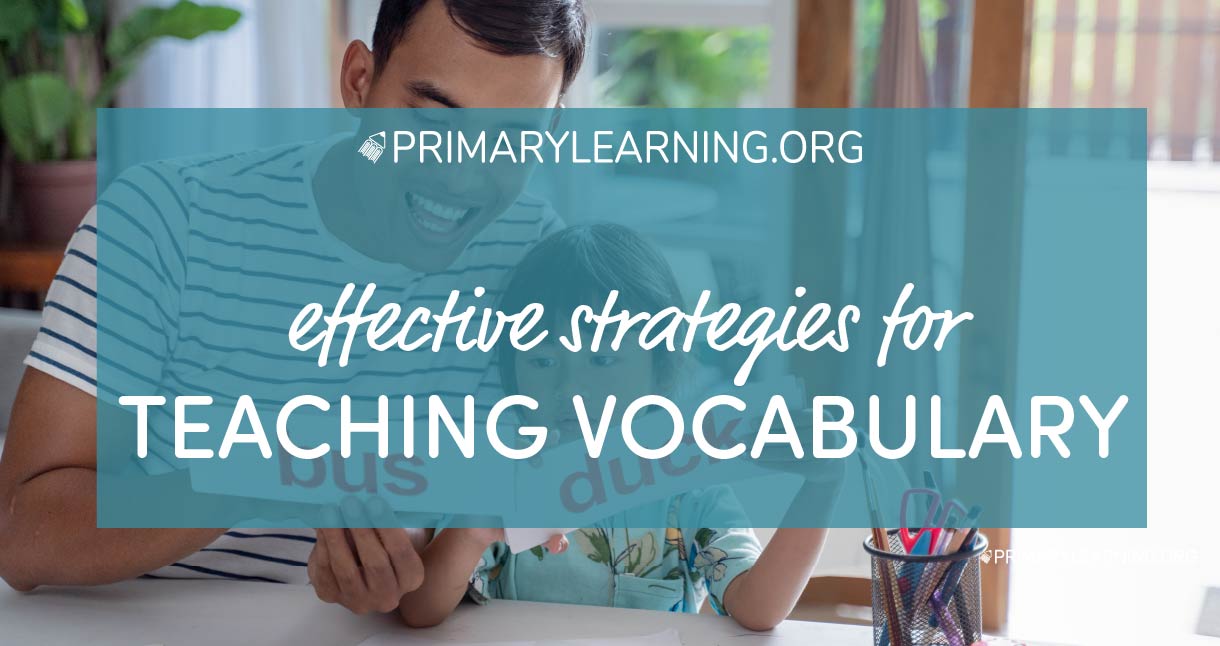

Posted by: Alesia Netuk
Updated: October 2nd, 2023
Effective Strategies for Teaching Vocabulary
Effective Strategies for Teaching Vocabulary
Teaching vocabulary is an important part of a language program. Developing students’ vocabulary will support them in reading, writing, and oral language. Weaving vocabulary lessons into your language program will help students learn in authentic contexts.
The Importance of Teaching Vocabulary
Having a well-developed vocabulary supports children in their reading. When words are part of a child’s spoken language, it can become easier for him to decode these words when encountering them in print. For example, if a child has never heard or used the word “deli,” when trying to figure out this word when it appears in a book, he may struggle because it’s not a term he’s familiar with. The child may rely on trying to sound the word out the best he can, but may have no other strategies to confirm if he has accurately solved the word. He can’t ask himself, “Does that sound right?” or “Does that make sense?” because the word is unknown to him.
Understanding vocabulary also supports children’s reading comprehension. If a child encounters too many unfamiliar words in a text, it will make it challenging for him to understand what he’s reading. Even if a child accurately decodes words in a story, without assigning meaning to them, his comprehension will decrease.
A well-developed vocabulary opens up possibilities for reading selections. As a child’s vocabulary expands, he is able to read and comprehend higher-level texts. This creates opportunities to choose from a wider variety of books. As children acquire more vocabulary, they are also able to explore more topics in literature. For example, they need to be familiar with specific vocabulary to read books about dinosaurs or farm machinery.
Teaching Methods
Children can learn many vocabulary words indirectly, through conversations, being read to, and other personal experiences. As toddlers, children begin learning vocabulary from the people around them, by listening to them to speak. Research shows that children also acquire vocabulary by being read to. They receive exposure to many new words and learn their meanings through the context of the story and through discussions with the adult reading to them. For example, a child who is unfamiliar with the word “gigantic” may talk about it with the adult, who uses the book’s picture to illustrate what the word means. Lastly, children learn new vocabulary from other sources, such as television, songs, and poems. They may learn more specialized vocabulary from experiences such as visiting the zoo or going to the beach.
While children’s vocabularies expand through indirect experiences with language, educators can also provide them with direct learning opportunities. Before presenting students with a new book, the educator can preview it and determine if there are any words the students may be unfamiliar with. Pre-teaching this vocabulary will better equip students to comprehend the text. Pre-teaching can take many different forms, such as a discussion about a vocabulary word, where the educator elicits what the students already know about it and provides further explanation. Educators may choose to facilitate a “turn and talk,” where students turn to a partner and discuss what they know about a vocabulary word. Pre-teaching vocabulary can also be accomplished by leading students in the creation of an anchor chart, where unfamiliar words are defined.
If educators prefer to have students complete an individual written activity, a graphic organizer such as a word map can be used. Educators can choose the format of the word map, with a vocabulary word written in the middle of the page and certain criteria written around it. For example, students may be asked to write a definition of the word, a synonym, an antonym, and to use the word in a sentence.
During independent reading times, where students have selected their own books to read, educators may have them maintain a personal list of vocabulary words. These are unfamiliar words the students come upon in their reading and need to seek out the meaning of. This approach allows students to learn new vocabulary words in context.
Educators may need to offer explicit teaching of specialized terminology in subjects such as math and science. For example, when teaching a unit on measurement, vocabulary such as “two-dimensional,” “area,” and “perimeter” may be introduced. Educators can help students define these words and find examples to demonstrate them. Students may benefit from having the vocabulary posted in the room where they can refer to it, along with their definitions and examples. A chart about shape words, like “hexagon” and “octagon”, may display the words, their definition, and a picture.
Students can learn new vocabulary through inferencing. Inferencing occurs when readers use context clues along with their own knowledge and experience to determine what a word means. For example, they may not understand the meaning of a word written in isolation. But when that word is embedded in a sentence, which is part of a larger story, readers may be able to determine what the word means. Educators can support inferencing by encouraging students to read to the end of the sentence or to the end of the paragraph, which may provide them with clues. Educators can also use prompts such as, “Think about what’s happening in the story” and “What would make sense right now?”
As students become more proficient readers and writers, it’s important for educators to continue focusing on the introduction of new vocabulary. Well-developed vocabularies will benefit students in all aspects of their receptive and expressive language.
Vocabulary activities:
Butterfly Life Cycle Vocabulary
Students create a map that tells what they know about butterfly transformation. Classmates describe how butterfly changes over the life cycle and show what they understand.
Butterfly Life Cycle Vocabulary
Summer: Cloze the Gap! Set 1
Kids replace the gaps with summer-related words. Summer vocabulary in this set: bees, ball, farm, flip-flops, hippo, insects, lemonade, ocean, picnic, roses.
Summer: Cloze the Gap! Set 1
Summer: Cloze the Gap! Set 2
Kids replace the gaps with summer-related words. Summer vocabulary: air conditioner, cocktail, flower, goggles, Independence Day, juice, lightning, nests, outdoors, sand.
Summer: Cloze the Gap! Set 2
Summer: Cloze the Gap! Set 3
Kids replace the gaps with summer-related words. Summer vocabulary: zipline, August, Fourth of July, journey, meditation, rabbits, sunflower, yacht, thunder, tan.
Summer: Cloze the Gap! Set 3
Summer: Cloze the Gap! Set 4
Kids replace the gaps with summer-related words. Summer vocabulary: vegetables, watermelon, sea, shell, queen bee, popsicle, nap, rope, holiday, grasshopper.
Summer: Cloze the Gap! Set 4
Easy Halloween Words in ABC Order
Kids learn easy Halloween words and write them in ABC order. Halloween Vocabulary: Halloween, pumpkin, bat, costume, black, broom, ghost, candy, witch, potion.
Easy Halloween Words in ABC Order
Vocabulary With Halloween Themed Words
Practice vocabulary skills in a fun way this holiday. Kids read Halloween words and match them with the picture. Halloween words: a broom, a bat, a ghost, a pumpkin, a candy, a potion.
Blending ID Family Words
Splitting a word into parts helps children spell the word. CVC words are the easiest to break into parts. Children practice segmenting and reading words from ID word family.
Blending ID Family Words
LEARNING MATERIALS TO MEET EVERY CHILD’S NEEDS
Here, at PrimaryLearning.Org, we tend to deliver the best-differentiated learning materials to K-2 students. Our resources can be easily incorporated into multisensory lessons to meet every child’s needs, whether s/he is a visual, kinesthetic, or auditory learner.